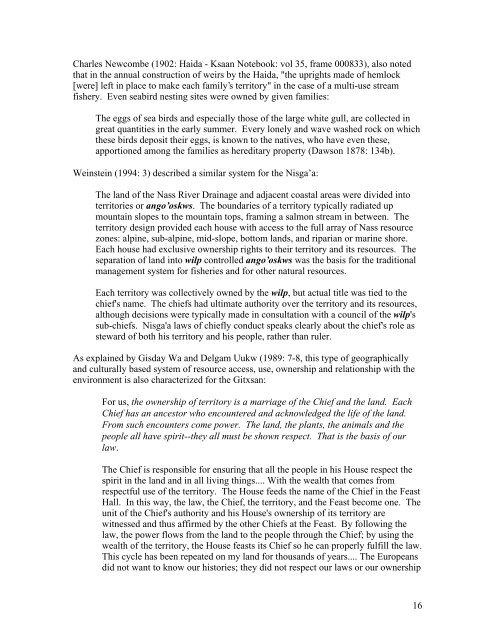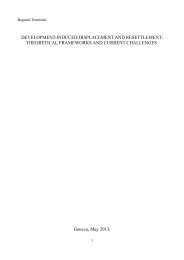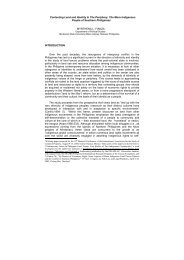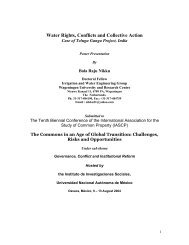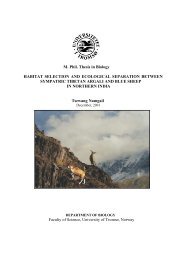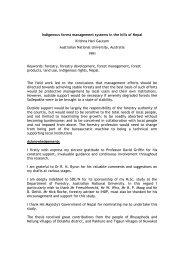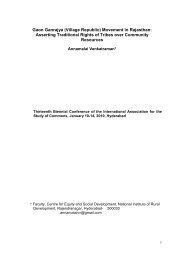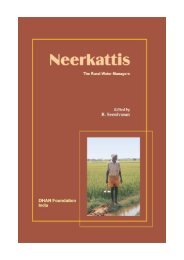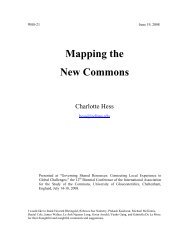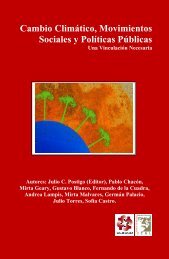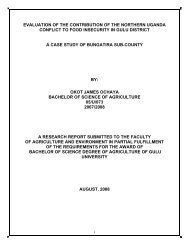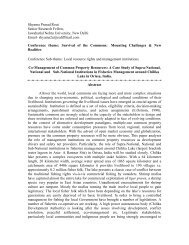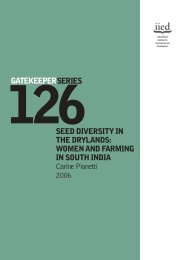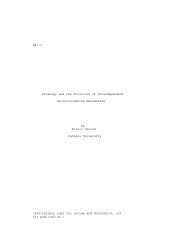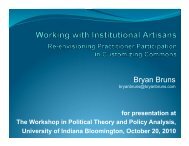Occupying the Land - Digital Library Of The Commons
Occupying the Land - Digital Library Of The Commons
Occupying the Land - Digital Library Of The Commons
You also want an ePaper? Increase the reach of your titles
YUMPU automatically turns print PDFs into web optimized ePapers that Google loves.
Charles Newcombe (1902: Haida - Ksaan Notebook: vol 35, frame 000833), also notedthat in <strong>the</strong> annual construction of weirs by <strong>the</strong> Haida, "<strong>the</strong> uprights made of hemlock[were] left in place to make each family’s territory" in <strong>the</strong> case of a multi-use streamfishery. Even seabird nesting sites were owned by given families:<strong>The</strong> eggs of sea birds and especially those of <strong>the</strong> large white gull, are collected ingreat quantities in <strong>the</strong> early summer. Every lonely and wave washed rock on which<strong>the</strong>se birds deposit <strong>the</strong>ir eggs, is known to <strong>the</strong> natives, who have even <strong>the</strong>se,apportioned among <strong>the</strong> families as hereditary property (Dawson 1878: 134b).Weinstein (1994: 3) described a similar system for <strong>the</strong> Nisga’a:<strong>The</strong> land of <strong>the</strong> Nass River Drainage and adjacent coastal areas were divided intoterritories or ango’oskws. <strong>The</strong> boundaries of a territory typically radiated upmountain slopes to <strong>the</strong> mountain tops, framing a salmon stream in between. <strong>The</strong>territory design provided each house with access to <strong>the</strong> full array of Nass resourcezones: alpine, sub-alpine, mid-slope, bottom lands, and riparian or marine shore.Each house had exclusive ownership rights to <strong>the</strong>ir territory and its resources. <strong>The</strong>separation of land into wilp controlled ango’oskws was <strong>the</strong> basis for <strong>the</strong> traditionalmanagement system for fisheries and for o<strong>the</strong>r natural resources.Each territory was collectively owned by <strong>the</strong> wilp, but actual title was tied to <strong>the</strong>chief's name. <strong>The</strong> chiefs had ultimate authority over <strong>the</strong> territory and its resources,although decisions were typically made in consultation with a council of <strong>the</strong> wilp'ssub-chiefs. Nisga'a laws of chiefly conduct speaks clearly about <strong>the</strong> chief's role assteward of both his territory and his people, ra<strong>the</strong>r than ruler.As explained by Gisday Wa and Delgam Uukw (1989: 7-8, this type of geographicallyand culturally based system of resource access, use, ownership and relationship with <strong>the</strong>environment is also characterized for <strong>the</strong> Gitxsan:For us, <strong>the</strong> ownership of territory is a marriage of <strong>the</strong> Chief and <strong>the</strong> land. EachChief has an ancestor who encountered and acknowledged <strong>the</strong> life of <strong>the</strong> land.From such encounters come power. <strong>The</strong> land, <strong>the</strong> plants, <strong>the</strong> animals and <strong>the</strong>people all have spirit--<strong>the</strong>y all must be shown respect. That is <strong>the</strong> basis of ourlaw.<strong>The</strong> Chief is responsible for ensuring that all <strong>the</strong> people in his House respect <strong>the</strong>spirit in <strong>the</strong> land and in all living things.... With <strong>the</strong> wealth that comes fromrespectful use of <strong>the</strong> territory. <strong>The</strong> House feeds <strong>the</strong> name of <strong>the</strong> Chief in <strong>the</strong> FeastHall. In this way, <strong>the</strong> law, <strong>the</strong> Chief, <strong>the</strong> territory, and <strong>the</strong> Feast become one. <strong>The</strong>unit of <strong>the</strong> Chief's authority and his House's ownership of its territory arewitnessed and thus affirmed by <strong>the</strong> o<strong>the</strong>r Chiefs at <strong>the</strong> Feast. By following <strong>the</strong>law, <strong>the</strong> power flows from <strong>the</strong> land to <strong>the</strong> people through <strong>the</strong> Chief; by using <strong>the</strong>wealth of <strong>the</strong> territory, <strong>the</strong> House feasts its Chief so he can properly fulfill <strong>the</strong> law.This cycle has been repeated on my land for thousands of years.... <strong>The</strong> Europeansdid not want to know our histories; <strong>the</strong>y did not respect our laws or our ownership16


